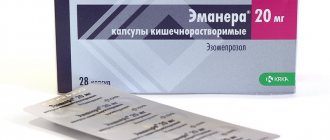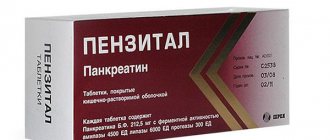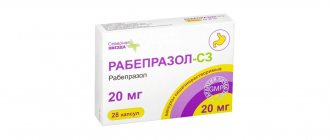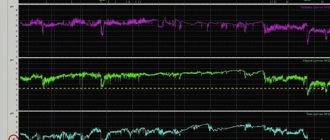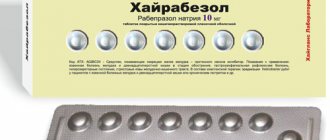Rabeprazole-SZ
Inside whole, without chewing. Time of day and food intake do not affect the activity of the drug.
Adults.
For gastric ulcers in the acute stage and anastomotic ulcers, it is recommended to take 10-20 mg once a day. Typically, the course of therapy is 6 weeks; in some cases, the duration of treatment can be increased by another 6 weeks.
For duodenal ulcers in the acute stage, it is recommended to take 10-20 mg once a day. The duration of treatment is from 2 to 4 weeks. If necessary, the duration of treatment can be increased by another 4 weeks.
When treating erosive gastroesophageal reflux disease or reflux esophagitis with the drug, it is recommended to take 10-20 mg once a day. The duration of treatment is from 4 to 8 weeks. If necessary, the duration of treatment can be increased by another 8 weeks.
For maintenance therapy of gastroesophageal reflux disease, it is recommended to take 10-20 mg once a day. The duration of treatment depends on the patient's condition.
For non-erosive gastroesophageal reflux disease, it is recommended to take 10-20 mg once a day. If symptoms do not disappear after four weeks of treatment, the patient should be further examined. After relief of symptoms, the drug should be taken at a dose of 10 mg once a day as required.
For the treatment of Solinger-Ellison syndrome and other conditions characterized by pathological hypersecretion, the dose is selected individually. The initial dose is 60 mg per day, then the dose is increased and the drug is prescribed at a dose of up to 100 mg per day with a single dose or 60 mg twice a day. Treatment should be carried out as clinically necessary. In some patients with Zollinger-Ellison syndrome, the duration of treatment was up to one year.
To eradicate Helicobacter pylori, it is recommended to take 20 mg 2 times a day according to a specific regimen with an appropriate combination of antibiotics. The duration of treatment is 7 days.
No dosage adjustment is required in patients with renal failure and elderly patients. In patients with mild to moderate hepatic impairment, blood concentrations of rabeprazole are usually higher than in healthy patients. When prescribing the drug to patients with severe insufficiency, caution should be exercised.
Children.
The safety and effectiveness of rabeprazole in children aged 12 years and older has been established for short-term (up to 8 weeks) treatment of gastroesophageal reflux disease. The recommended dose for children aged 12 years and older is 20 mg once daily for up to 8 weeks. Safety and effectiveness for other indications have not been established in pediatric patients.
Rabeprazole
Rabeprazole
(lat.
rabeprazole
) - antiulcer medicine, proton pump inhibitor. Rabeprazole is the international nonproprietary name (INN) of the drug. According to the pharmacological index, rabeprazole belongs to the group “Proton pump inhibitors”. According to ATC, it belongs to the group “Proton pump inhibitors” and has the code A02BC04. Rabeprazole, in addition, the trade name of the drug is a Russian-made generic.
Rabeprazole is a chemical substance
Rabeprazole is a substituted benzimidazole derivative: 2-[[[4-(3-Methoxypropoxy)-3-methyl-2-pyridyl]methyl]sulfinyl]benzimidazole. The empirical formula is C18H21N3O3S. Molecular weight 381.43. Rabeprazole sodium is a white or slightly yellowish-white substance, very soluble in water and methanol, soluble in ethanol, chloroform and ethyl acetate and insoluble in ether and n-hexane. Weak foundation. The stability of rabeprazole depends on the acidity of the environment - it is quickly destroyed in moderate acids and is more stable in an alkaline environment.
Indications for use of rabeprazole
- gastric ulcer (GUD) and duodenal ulcer (DU) in the acute stage
- gastroesophageal reflux disease (GERD)
- pathological hypersecretion of hydrochloric acid, including Zollinger-Ellison syndrome
- eradication of Helicobacter pylori in patients with gastritis or chronic gastritis (only as part of combination therapy with antibiotics)
- treatment and prevention of relapses of peptic ulcer associated with Helicobacter pylori (only as part of combination therapy with antibiotics)
Contraindications to the use of rabeprazole
- hypersensitivity to rabeprazole
- pregnancy
- lactation
Restrictions on the use of rabeprazole
- severe liver failure
- childhood
- Long-term or high-dose use of rabeprazole increases the risk of hip, wrist, and spine fractures (“FDA Warns”)
Method of administration of rabeprazole and dose
Rabeprazole tablets are swallowed whole without chewing or crushing. Doses and duration of use of rabeprazole depend on the disease:
- Peptic ulcer in the acute stage - 20 mg once a day for 4 weeks, with poor healing - additionally for another 4 weeks
- DU - 10 or 20 mg once a day for 6 weeks, if healing is poor - another 6 weeks
- GERD - 20 mg once a day for 4-8 weeks, maintenance therapy is possible in the future: 10-20 mg once a day
- eradication of Helicobacter pylori as part of triple therapy: rabeprazole 20 mg twice a day, clarithromycin - 500 mg per day and amoxicillin - 1000 mg per day for 7 days (see also Standards for the diagnosis and treatment of acid-related and Helicobacter pylori-associated diseases, which also present other eradication schemes).
Time of administration and food do not affect the activity of rabeprazole, but it is believed that patients comply better with the prescribed treatment regimen if rabeprazole is taken in the morning, half an hour before meals (with a single dose per day).
There are studies proving that dividing the daily dose of rabeprazole into 2-4 doses per day reduces stomach acidity, however, such split doses may have a downside - a decrease in adherence to treatment (Evsyutina Yu.V.).
Over-the-counter rabeprazole medications
In Russia, in particular, the following rabeprazole preparations are approved for over-the-counter sale: Bereta, Noflux, Pariet, Rabiet, capsule dosage form containing 10 mg of rabeprazole sodium (or rabeprazole).
The general rule when taking over-the-counter proton pump inhibitors (including rabeprazole): if there is no effect within the first three days, consultation with a specialist is necessary. The maximum period of treatment with over-the-counter proton pump inhibitors without consulting a doctor is 14 days. The interval between 14-day courses must be at least 4 months. Rabeprazole in a reduced dose compared to the therapeutic dose has been approved for sale in pharmacies in Australia since 2010, and later in the UK.*
All over-the-counter forms have a reduced content of active substance and are intended “for the treatment of frequent heartburn.”
* Boardman HF, Heeley G. The role of the pharmacist in the selection and use of over-the-counter proton-pump inhibitors. Int J Clin Pharm (2015) 37:709–716. DOI 10.1007/s11096-015-0150-z.
Publications for Health Professionals
- Pakhomova I.G. A multimorbid patient with GERD and pathology of the cardiovascular system receiving antiplatelet therapy. Possibility of choosing a proton pump inhibitor using a clinical example. Medical advice. 2019;(14):10-16.
- Maev I.V., Goncharenko A.Yu., Kucheryavyi Yu.A. The effectiveness of monotherapy with omeprazole and rabeprazole in patients with erosive reflux esophagitis in old age // Clinical perspectives of gastroenterology and hepatology. – 2007. – No. 2. – p. 31–36.
- Warrington Steve, Baisley Kathy, Dunn Kate et al. Effects of a single dose of rabeprazole 20 mg and esomeprazole 40 mg on intragastric 24-hour pH measurements in healthy volunteers // Eur J Clin Pharmacol. – 2006. – No. 62. - With. 685–691.
- Khavkin A.I., Rachkova N.S., Zhikhareva N.S., Khanakaeva Z.K. Prospects for the use of proton pump inhibitors in pediatrics // Russian Medical Journal. – 2003. – Volume 11. – No. 3. – p. 134–138.
- Morozov S.V., Tsodikova O.M., Isakov V.A. and others. Comparative effectiveness of the antisecretory action of rabeprazole and esomeprazole in individuals who rapidly metabolize proton pump inhibitors // Experimental and clinical gastroenterology. – 2003. – No. 6.
- Rudakova A.V. Pharmacoeconomic aspects of the use of rabeprazole and esomeprazole in patients with gastroesophageal reflux disease // Consilium-Medicum. – 2006. – Volume 8. – No. 2.
- Yastrebkova L.A. Comparative clinical effectiveness and safety of rabeprazole (Pariet) and esomeprazole (Nexium) in the treatment of acid-related diseases of the gastrointestinal tract // MEDGAZETA. 07/08/2009.
- Abdulganieva D.I. Variability of daily pH-metry in patients with duodenal ulcer after a single dose of rabeprazole // RZHGGK 2010. No. 6. P. 76–80.
- Marelli S., Pace F. Use of rabeprazole for the treatment of acid-related diseases // Reprint. Expert Review Gastroenterology & Hepatology 6 (4), 423-435 (2012).
- Shulpekova Yu.O. The use of rabeprazole in the practice of a gastroenterologist // Medical Council. Gastroenterology. No. 14. 2016, pp. 26-31.
- Kareva E.N. Rabeprazole through the prism of “metabolism - effectiveness” // RMJ. 2016. October.
- Starodubtsev A.K., Fedorov S.P., Serebrova S.Yu. and others. Evaluation of the clinical effectiveness of rabeprazole depending on the individual type of parietal cell reception in various acid-dependent diseases. stomach and duodenum // Biomedicine. 2010. No. 1. P. 69–77.
- Bakulin I.G., Tikhonov S.V., Bakulina N.V., Zhuravleva M.S., Bordin D.S., Vasiliev R.V. Ineffectiveness of GERD therapy: risk factors and treatment reserves. Opinion Leader. No. 38. 2022. Interdisciplinary approach: rheumatology, gastroenterology. P.31-38.
- Kazyulin A.N., Shindina T.S., Shcherbenkov I.M., Arkhipova CC Proton pump inhibitors - focus on the multimorbid patient. RMJ. 2021;10:27-30.
On the website GastroScan.ru in the “Literature” section there is a subsection “Rabeprazole”, containing publications for healthcare professionals on the treatment of the gastrointestinal tract with rabeprazole.
Videos (reports and lectures) for healthcare professionals
| | Bordin D.S. Errors in diagnosis and treatment of GERD |
| | Kaibysheva V.O. Personalized approach to the diagnosis and treatment of GERD |
| | Alekseenko S.A. GERD complicated by pathology of ENT organs, diagnostic possibilities |
| Tsukanov V.V. Rational choice of PPI for a comorbid patient with GERD | |
| Bordin D.S. The most common mistakes in diagnosing and treating GERD | |
| Kareva E.N. Could a patient's genetic makeup be the cause of refractory GERD? Pharmacogenetic management of PPI effectiveness |
On the website GastroScan.ru in the “Video” section there is a subsection “For Doctors”, containing video recordings of reports, lectures, webinars in various areas of gastroenterology for healthcare professionals.
Pharmacokinetics of rabeprazole
Rabeprazole is rapidly absorbed from the small intestine, with Cmax in blood plasma reached approximately 3.5 hours after taking a dose of 20 mg.
Cmax and AUC are linearly dependent on the dose of rabeprazole over the dose range from 10 to 40 mg. Bioavailability after oral administration of 20 mg is approximately 52%, mainly due to first-pass metabolism through the liver. Bioavailability does not change with repeated doses of rabeprazole. In healthy people, T½ of rabeprazole from blood plasma is about an hour (40–90 min), and the total clearance is (283 ± 98) ml/min. In patients with chronic liver diseases, AUC is two times higher than in healthy people, indicating a decrease in first-pass metabolism, and T½ of rabeprazole from blood plasma is increased by 2-3 times. Food and time of administration during the day do not affect the absorption of rabeprazole.
The degree of binding of rabeprazole to plasma proteins is about 97%.
The main metabolites present in blood plasma are thioester and carboxylic acid. In addition, minor metabolites are present in small concentrations: sulfone, demethylthioether and mercapturic acid conjugate.
After a single dose of 20 mg of rabeprazole, labeled with the 14C carbon isotope, no excretion of rabeprazole unchanged in the urine is observed. About 90% of rabeprazole is excreted in the urine in the form of two metabolites: a conjugate of mercapturic acid and carboxylic acid, and about 10% in feces.
After a single dose of 20 mg of rabeprazole with similar body weight and height, there are no noticeable differences in pharmacokinetics in men and women.
In patients with stable end-stage renal failure requiring hemodialysis (creatinine clearance ≤5 ml/min/1.73 m2), the distribution of rabeprazole differs little from the distribution in healthy people. AUC and Cmax in such patients are approximately 35% lower than in healthy controls. On average, T½ of rabeprazole was 0.82 hours in healthy people, 0.95 hours in patients undergoing hemodialysis, and 3.6 hours after hemodialysis. The clearance of rabeprazole in patients with kidney disease requiring hemodialysis is approximately 2 times higher than in healthy people.
After a single dose of 20 mg of rabeprazole in patients with chronic liver failure, the AUC doubles and T½ increases 2-3 times compared to healthy people. After taking rabeprazole 20 mg per day for 7 days, AUC increases only 1.5 times, and Cmax increases by 1.2 times. T½ of rabeprazole in patients with liver failure is approximately 12.3 hours compared to 2.1 hours in healthy people. The pharmacodynamic response observed using intragastric pH-metry was similar in both groups.
In elderly patients, the elimination of rabeprazole is slowed down. After 7 days of rabeprazole 20 mg per day, the AUC was approximately twice as high and the Cmax was increased by 60% in elderly patients compared to young and healthy patients. However, there are no signs of accumulation of rabeprazole.
In patients with slow metabolism of CYP2C19, after 7 days of taking rabeprazole at a dose of 20 mg per day, AUC increases by 1.9 times and T½ by 1.6 times compared to the same parameters in patients with rapid metabolism, while Cmax increases by 40%.
Pharmacodynamics of rabeprazole
In the acidic environment of the parietal cells of the gastric mucosa, rabeprazole is converted into the active sulfenamide form, which interacts with the proton pump (H+/K+-ATPase).
Inhibits (partially reversibly) the proton pump of parietal cells and dose-dependently blocks the secretion of hydrochloric acid. The antisecretory effect of rabeprazole appears within an hour after oral administration of a dose of 20 mg. The maximum decrease in stomach acidity occurs 2-4 hours after taking the first dose. On the first day, it reduces the average daily acidity level by 6% (this is about 88% of the reduction in secretion achieved on the 8th day of treatment). The acidity of the stomach on average per day is approximately 3.4 pH; the time during which acidity remains above 3 pH - 55.8%. Partial dissociation of the complex with the proton pump causes a shorter duration of action than that of irreversible proton pump inhibitors. The duration of inhibition of basal and stimulated secretion reaches two days, a stable antisecretory effect develops after three days of treatment. Withdrawal is not accompanied by the phenomenon of acid rebound; restoration of secretory activity occurs within 2–3 days as new proton pumps are synthesized. It has anti-Helicobacter activity: the minimum inhibitory concentration is 4–16 μg/ml. Accelerates the manifestation of anti-Helicobacter activity of a number of antibiotics. When carrying out triple eradication therapy (rabeprazole 20 mg twice daily with clarithromycin and amoxicillin) 90% eradication of Helicobacter pylori
(Нр) is achieved within 4 days. Hp eradication at the end of a 7-day course of therapy is observed in 100, 95, 90 and 63% of cases, respectively, when treated with rabeprazole in combination with clarithromycin + metronidazole, clarithromycin + amoxicillin, amoxicillin + metronidazole, or clarithromycin alone. For erosive or ulcerative gastroesophageal reflux disease, it reduces heartburn from the first day of treatment (10–20 mg). Effective in 8-week treatment of erosive reflux esophagitis in 84% of patients. Also effective in pathological hypersecretory conditions, including Zollinger-Ellison syndrome. In the first 2–8 weeks of long-term use, the concentration of gastrin in the blood serum temporarily increases (histological examination does not show an increase in the number of enterochromaffin-like cells, the frequency of intestinal metaplasia, or Hp colonization). When taking acid-resistant enteric-coated tablets orally, absorption begins in the small intestine and is rapid and complete. Absolute bioavailability - 52% (pronounced “first pass” effect through the liver). Food and timing of rabeprazole do not alter bioavailability. Cmax is achieved within 2–5 hours (on average 3.5 hours) after taking a dose of 20 mg. There is a linear dependence of the Cmax and AUC values on the dose in the range from 10 to 40 mg. T½ is 0.7–1.5 hours; total clearance - 283 ml/min. Against the background of hepatic cell failure, the “first pass” effect through the liver is not expressed, AUC is increased by 2 times (after a single dose) and 1.5 times (after 7 days of therapy), T½ reaches 12.3 hours. Rabeprazole is metabolized in the liver with the participation of cytochrome P450 isoenzymes CYP2C19 and CYP3A4 with the formation of inactive metabolites and demethylthioether, which has weak antisecretory activity. In the case of delayed biotransformation, after 7 days of administration at a dose of 20 mg/day, T½ reaches 1–2 hours (on average 1.6 hours), Cmax increases by 40%. It is excreted primarily in the urine in the form of conjugates of mercapturic and carboxylic acids. In old age, the biotransformation of rabeprazole slows down, Cmax increases by 60%, AUC - 2 times. Even at the stage of end-stage renal failure in patients on dialysis, the pharmacokinetic parameters change slightly - Cmax and AUC decrease by 35%, T½ during hemodialysis is 0.95 hours, after - 3.6 hours.
Use of rabeprazole during pregnancy and breastfeeding
The FDA fetal risk category for rabeprazole in pregnant women is C* (animal studies have shown adverse effects on the fetus and there have been no adequate studies in pregnant women, but the potential benefits associated with the use of this drug in pregnant women may justify its use, despite the risk).
Breastfeeding should be stopped during treatment.
Note. *Previously, until 2014, rabeprazole was category B.
Side effects of rabeprazole
- digestive system: diarrhea, nausea; less often - vomiting, abdominal pain, flatulence, constipation; rarely - dry mouth, belching, dyspepsia; in isolated cases - impaired taste, anorexia, stomatitis, gastritis, increased transaminase activity
- nervous system and sensory organs: headache; less often - dizziness, asthenia, insomnia; very rarely - nervousness, drowsiness; in some cases - depression, visual impairment
- musculoskeletal system: rarely - myalgia; very rarely - arthralgia, calf muscle cramps
- respiratory organs: rarely - inflammation or infection of the upper respiratory tract, severe cough; very rarely - sinusitis, bronchitis
- allergic manifestations: rarely - rash, skin itching
- other: rarely - pain in the back, chest, limbs, swelling, urinary tract infection, fever, chills, flu-like syndrome; in isolated cases - increased sweating, weight gain, leukocytosis
Interaction of rabeprazole with other drugs
Rabeprazole reduces the concentration of ketoconazole in plasma by 33%, increases the concentration of digoxin by 22%.
Does not interact with liquid antacids. Rabeprazole is compatible with drugs metabolized by the P450 system, such as warfarin, phenytoin, theophylline and diazepam. If it is necessary to take proton pump inhibitors and clopidogrel simultaneously, the American Heart Association recommends taking pantoprazole instead of rabeprazole (Bordin D.S.). However, recently there have been publications claiming that rabeprazole should be the drug of choice among other PPIs when taking clopidogrel and PPIs together (Pakhomova I.G.).
Rabeprazole overdose
There are no known symptoms of rabeprazole overdose. If an overdose of rabeprazole is suspected, supportive and symptomatic therapy is recommended. Dialysis is ineffective.
Precautions during rabeprazole therapy
Before starting treatment with rabeprazole, it is necessary to exclude a malignant neoplasm of the stomach, since symptomatic improvement when taking rabeprazole may complicate timely diagnosis. Caution is recommended when first prescribing rabeprazole to patients with severely impaired liver function. If drowsiness occurs, you should avoid driving and other similar activities. Patients receiving ketoconazole or digoxin concomitantly with rabeprazole require additional monitoring, as dosage adjustments of these drugs may be required.
Comparison of rabeprazole with other proton pump inhibitors
On the Russian market, rabeprazole is sold in its original form under the brand name “Pariet”. Being one of the most modern drugs that reduce gastric acidity, Pariet differs from other antisecretory drugs in its high price. Russian gastroenterologists do not have a consensus regarding the unique properties and cost-effectiveness of using Pariet. These issues are discussed in more detail in the article “ Pariet
” in the section “Comparison of Pariet with other proton pump inhibitors.”
Slide from the report by S.Yu. Serebrova “Original PPIs and generics: modern problems of assessing substitution” at the Eschevod-2015 conference
In the work of Yu.M. Spivakovsky et al. it is stated that omeprazole and rabeprazole showed comparable effectiveness, safety profile, and tolerability when used in the course of treatment of chronic hepatitis in children and that no significant advantages were noted for each of the drugs.
Medicines containing the active ingredient rabeprazole
In Russia, the following drugs with the active ingredient rabeprazole are registered for sale in pharmacies: Bereta (Veropharm, Russia), Zulbex, Noflux (former name Zolispan), Ontime, Pariet (manufactured by Eisai Co.Ltd (Japan), Janssen Pharmaceutica (Italy), Jansen (Belgium)), Rabeloc, Rabeprazole-OBL (produced by the Russian company Obolenskoye), Rabeprazole-SZ, Rabiet, Razo, Khairabezol.
Most of them are available in the form of tablets for oral administration, coated with an intestinal soluble coating, containing 10 or 20 mg of the active substance - rabeprazole. In the USA and several other countries, Pariet is sold under the brand name AcipHex.
In a number of countries - former republics of the USSR, medicines with the active substance rabeprazole produced by Macleods Pharmaceuticals Ltd, India, are registered, in particular: in Kazakhstan
- Rabemak 10 and Rabemak 20,
in Ukraine
- Rabimak (Ukrainian rabіmak), as well as Rabelok (Ukrainian Rabelok) produced by Cadila Pharmaceuticals, Ltd., India In addition, there are a number of others on the pharmaceutical markets of the former USSR republics in Russia, drugs with the active substance rabeprazole, in particular: Barol-20 (Themis Laboratories Pvt. Ltd., India), Geerdin - powder for the preparation of solution for injection and enteric-coated tablets (Mepro Pharmaceuticals, India and Mili Healthcare Ltd , UK), Rabezol (Med-Interplast, India), Rabeprazole-health (Ukraine), Razol-20 (Biogenics Limited, India) and others.
In addition, specifically for the eradication of Helicobacter pylori
Combination medications are produced that contain drugs that correspond to one of the eradication regimens. An example of such a medicine presented on the Ukrainian market is ornistat, containing rabeprazole and two antibiotics: clarithromycin and ornisadol.
The optical isomer of rabeprazole, dexrabeprazole, has been included in the ATC since 2015 and is assigned the code A02BC07.
Doctor of Medical Sciences
D.S. Bordin presents the results of daily pH monitoring of a patient before and after parenteral administration of rabeprazole (40th Scientific Session of the Central Research Institute of Gastroenterology). Rabeprazole has contraindications, side effects and application features; consultation with a specialist is necessary. Back to section
Rabeprazole-SZ 20 mg 28 pcs. enteric capsules in Anapa
Rabeprazole-SZ capsules should be swallowed whole. It has been established that neither time of day nor food intake affects the activity of rabeprazole. For gastric ulcers in the acute stage and anastomotic ulcers, it is recommended to take 10 mg or 20 mg orally once a day. Usually cure occurs after 6 weeks of therapy, but in some cases the duration of treatment can be increased by another 6 weeks.
For duodenal ulcers in the acute stage, it is recommended to take 20 mg orally once a day. In some cases, a therapeutic effect occurs when taking 10 mg once a day. The duration of treatment is from 2 to 4 weeks. If necessary, the duration of treatment can be increased by another 4 weeks.
When treating erosive gastroesophageal reflux disease (GERD) or reflux esophagitis, it is recommended to take 10 mg or 20 mg orally once a day. The duration of treatment is from 4 to 8 weeks. If necessary, the duration of treatment can be increased by another 8 weeks.
For maintenance therapy of gastroesophageal reflux disease (GERD), it is recommended to take 10 mg or 20 mg orally once a day. The duration of treatment depends on the patient's condition.
For non-erosive gastroesophageal reflux disease (NERD) without esophagitis, it is recommended to take 10 mg or 20 mg orally once a day
If symptoms do not disappear after four weeks of treatment, the patient should be further examined. After relief of symptoms, to prevent their subsequent occurrence, the drug should be taken orally at a dose of 10 mg once a day as required.
For the treatment of Zollingeo-Ellison syndrome and other conditions characterized by pathological hypersecretion. the dose is selected individually. The initial dose is 60 mg per day, then the dose is increased and the drug is prescribed at a dose of up to 100 mg per day with a single dose or 60 mg twice a day. For some patients, fractional dosing of the drug is preferable. Treatment should be continued as clinically necessary. In some patients with Zollinger-Ellison syndrome, the duration of treatment with rabeprazole was up to one year.
For Helicobacter pylori
It is recommended to take 20 mg orally 2 times a day according to a specific regimen with appropriate combinations of antibiotics. The duration of treatment is 7 days.
Patients with renal and hepatic insufficiency No dose adjustment is required for patients with renal insufficiency. In patients with mild to moderate hepatic impairment, blood concentrations of rabeprazole are usually higher than in healthy volunteers. When prescribing Rabeprazole-SZ to patients with severe liver failure, caution should be exercised. Elderly patients No dose adjustment is required.
Children
The safety and effectiveness of rabeprazole 20 mg for the short-term (up to 8 weeks) treatment of GERD in children 12 years of age and older is supported by extrapolation from adequate and well-controlled studies supporting the effectiveness of rabeprazole in adults and safety and pharmacokinetic studies in pediatric patients. The recommended dose for children aged 12 years and over is 20 mg once daily for up to 8 weeks.
The safety and effectiveness of rabeprazole for the treatment of GERD in children younger than 12 years of age have not been established. The safety and effectiveness of rabeprazole for other indications has not been established in pediatric patients.
